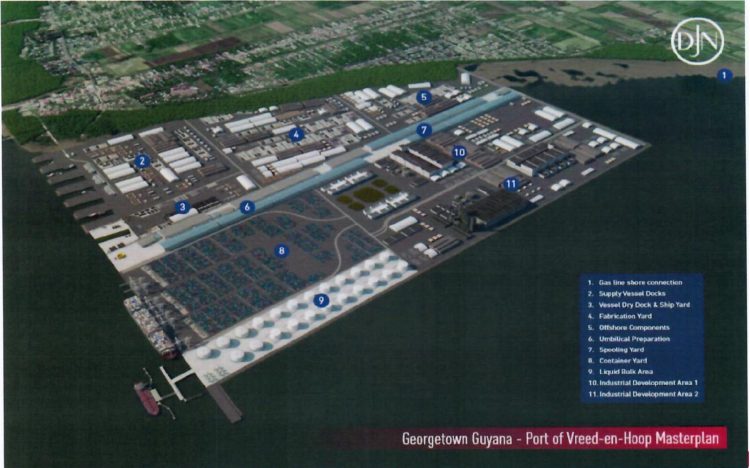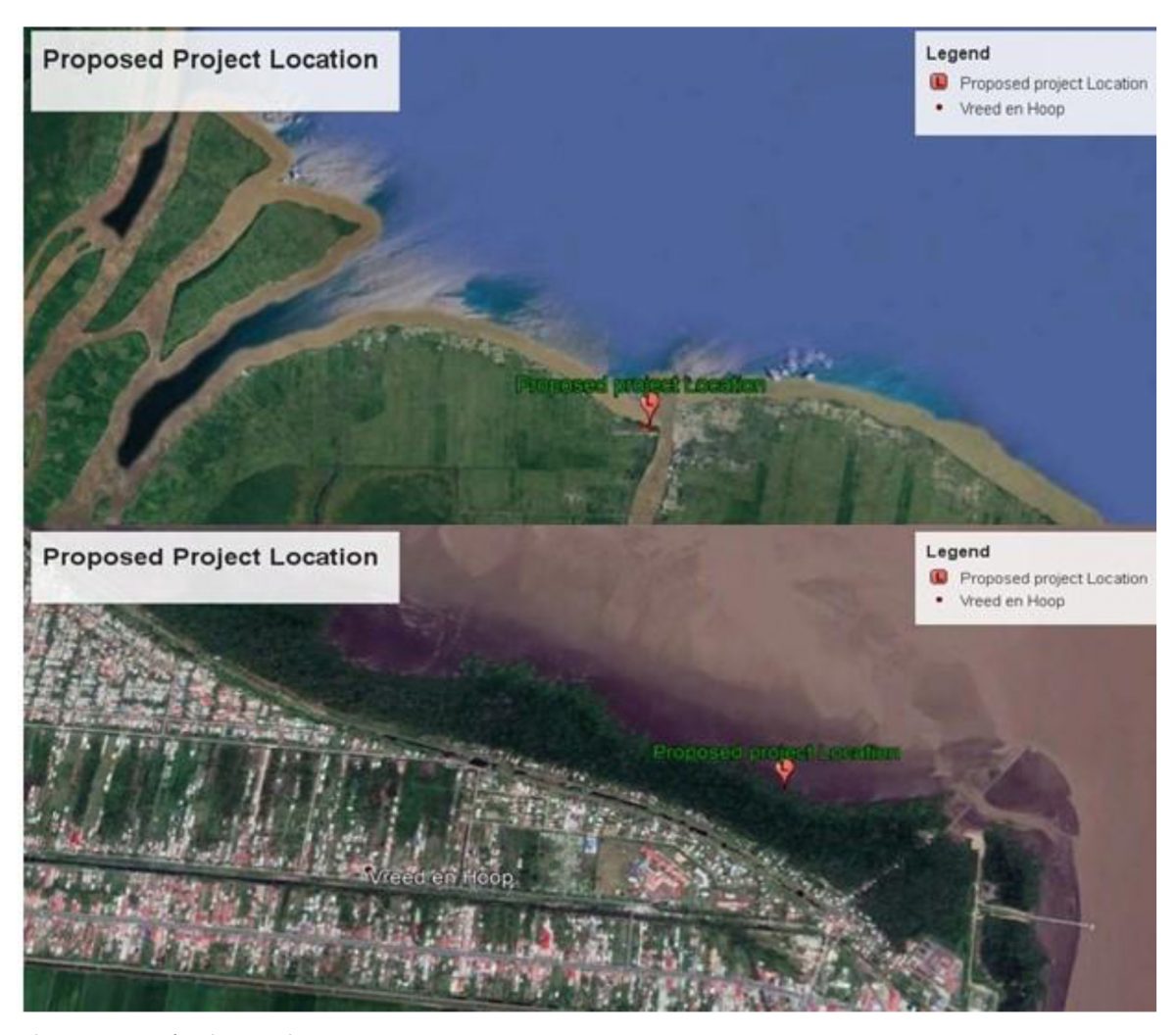An investment of US$200 to US$600 million has been proposed for the nearly 1,000-acre Best Village, West Bank of Demerara, oil and gas shore base development, a project summary by the Environmental Protection Agency (EPA) states.
The consortium of local companies executing the investment says that mangrove destruction will be “insignificant”. Mangroves on the West Demerara were controversially removed by another company planning a shore base, Tristar.
“The proposed project area will fringe approximately 60 ha of mangrove forest comprising mainly black mangroves (Avicennia germinans)…” the project summary, uploaded on the EPA’s website on Tuesday stated.
 “… It must be noted that the proposed project does not contemplate large scale removal of the mangrove forest in the area. The plan is to leave the existing forest intact as far as practical. There may be some minor impacts due to clearance for example access road, but these are expected to be insignificant. The final designs will articulate the level of footprint expected,” it adds.
“… It must be noted that the proposed project does not contemplate large scale removal of the mangrove forest in the area. The plan is to leave the existing forest intact as far as practical. There may be some minor impacts due to clearance for example access road, but these are expected to be insignificant. The final designs will articulate the level of footprint expected,” it adds.
On Monday, Stabroek News reported that local businessman and gold miner, Andron Alphonso, is investing in the oil & gas sector and has applied to the EPA to set up a shore base facility at Best Village.
The project is being undertaken through NRG Holdings Inc, a consortium of three local entrepreneurs including Alphonso, whose company is ZRN Investment Inc. The other two are HADI’S World Incorporated owned by Nazar ‘Shell’ Mohammed and National Hardware Guyana Ltd with its representative, Nicholas Deygoo.
The EPA has stated that the Best Village shore base would not require an Environmental Impact Assessment, noting that the project was screened and categorised as having no significant impacts. And while the EPA did not state that the proposed facility would be in an area with mangroves, it noted that “detailed specific mitigation measures” should be explained. The EPA’s decision to not require an EIA for these large oil and gas projects has raised concerns.
The agency said that it will also prescribe in its authorisation, robust measures and safeguards to ensure compliance with its Act and that an Environmental and Social Management Plan is required to be prepared to address specific issues identified in the screening process.
According to the project summary, the project “is estimated to cost approximately US$200-600 million” which shall include geotechnical and environmental studies, engineering works, dredging operations, reclamation, and the construction of wharf, storage, warehouse, and safety facilities.
It describes the proposed initiative as “an industry leading shore base facility for the oil & gas sector including the possible environmental and social impacts” and with an overall goal “to develop this landmark facility as a means of equipping and bringing tremendous value to locals in the management and operation of the emerging oil & gas sector while directly meeting the high standards of overall industry needs.” It continued, “This space will be developed into sustainable and industry leading facilities showcasing what can be done through local content, investment, and international partnership.”
Of its proposed 988 acres (400 hectares) of coastal and nearshore lands and water located seaward of existing mangroves on the Atlantic coast at Best Village, the project summary says that 148 acres of that area has mangroves.
“The coastal area consists of a combination of natural and man-made sea defence structures, tidal mud banks and beaches, and approximately 60 ha [hectares] of mangrove forests. The proposed site is bounded to the east by the confluence of the Demerara River; the west by the foreshore of Best Village; the south by mangrove forest; and north, the Atlantic Ocean,” the summary informs.
Addressing possible environmental and social impacts, the project outline says that the main activities associated with the project during the construction phase are: land clearing, earthworks, stockpiling, machine operation, and concrete works, and they will have the potential to affect the environment “directly or indirectly.”
“The potential impacts are loss of land and habitats, pollution of air and sedimentation of surface water, generation of solid waste, and health and safety related. The impacts, however, are expected to be insignificant and short term in duration and therefore mitigable,” the document states.
It gives a breakdown of expected impacts and mitigation measures the company has in place for air quality and noise, social, human health and safety, and mangroves and fauna.
Emphasised throughout the summary was that environmental monitoring programmes will be implemented to address all activities that have been identified to have any potential impacts on the environment during normal operations and upset conditions.
Underscoring that the shorebase plan is being executed to add to both local content and partner with government as it builds a holistic development plan for Guyana, the project summary notes that inadequate facilities for this country’s oil & gas sector leads to opportunities being gobbled up by other countries such as Trinidad and Tobago.
“This proposed project will help the Government of Guyana meet its strategic priorities to boost the economy and stimulate job growth along with helping the country expand key shipping, port, and shore base facilities to rapidly meet industry requirements,” the summary states.
“The Port of Vreed-en-Hoop will be established, inter alia, by a consortium of leading local entrepreneurs highlighting the capabilities of Guyanese and 100% indigenous ownership of this project (the “Consortium”). The goal is to develop a landmark facility that will equip and bring tremendous value to the management and operation of the emerging oil & gas sector while directly meeting the high standards of overall industry needs,” it adds.
It estimates that there will be job opportunities for approximately 150 to 200 persons during construction phase and 50 to 100 persons for the basic operation and maintenance of the base port facilities. The company said that once the Phase 1 components are fully operational, inclusive of service providers, approximately 1,000 persons will be employed. This number is expected to double with Phase 2 components completed and operationalised.
The port is expected to comprise but is not necessarily limited to: an offshore terminal, fabrication, umbilical and spooling yards, administrative buildings which will house offices and modernised logistics centres, warehousing, container management systems and potential for storage of sub-sea equipment, pipe inspection and repairs, areas for individual and separate operators to provide relevant services to the offshore oil and gas operators including but not limited to waste management/effluent treatment plant(s), other environmental services, lodgings and mud plant.
There will also be areas for a wharf, berths, dry dock, and a potential helipad.
Of the many services to be provided, the project notes that the local economy will benefit from employment, duties and taxes, ancillary goods and services, and capacity-building, as it emphasises that this country must now seize the opportunity that comes with the growing sector.
It contends that since oil was discovered here in 2015, many jobs have gone to other countries because this country isn’t equipped with the facilities needed. “Guyana will continue to lose out under the current arrangement, unless increased emphasis is placed on the development of these supporting facilities that capture these benefits in-country, and direct them into the development of the Guyanese people. “Guyana’s Government and the private sector will have to work together to ensure that they benefit from these opportunities through infrastructure development and building the requisite skills and competence in all possible respects to capitalize on the opportunities that the new sector is anticipated to bring. The oil & gas rapid growth and the country’s economic transformation is expected to be substantial, with opportunities for infrastructural and logistical,” the summary also declares.





